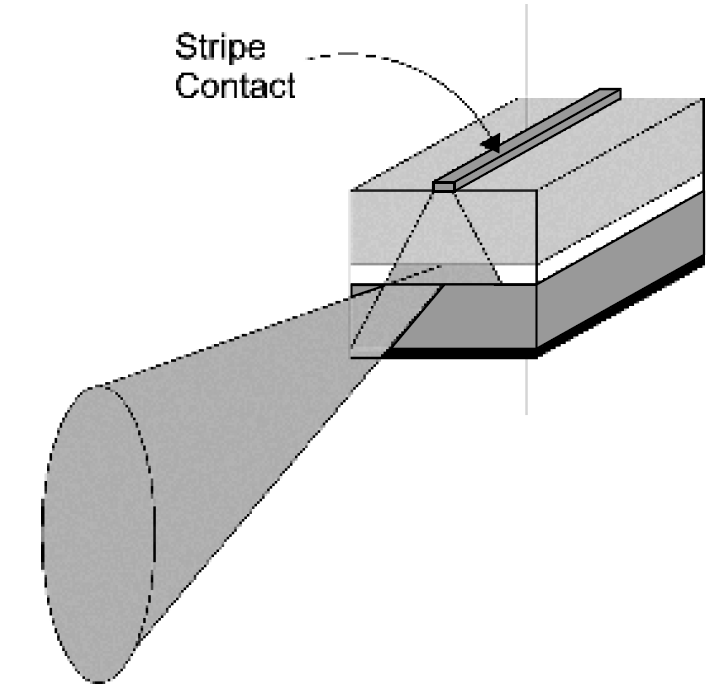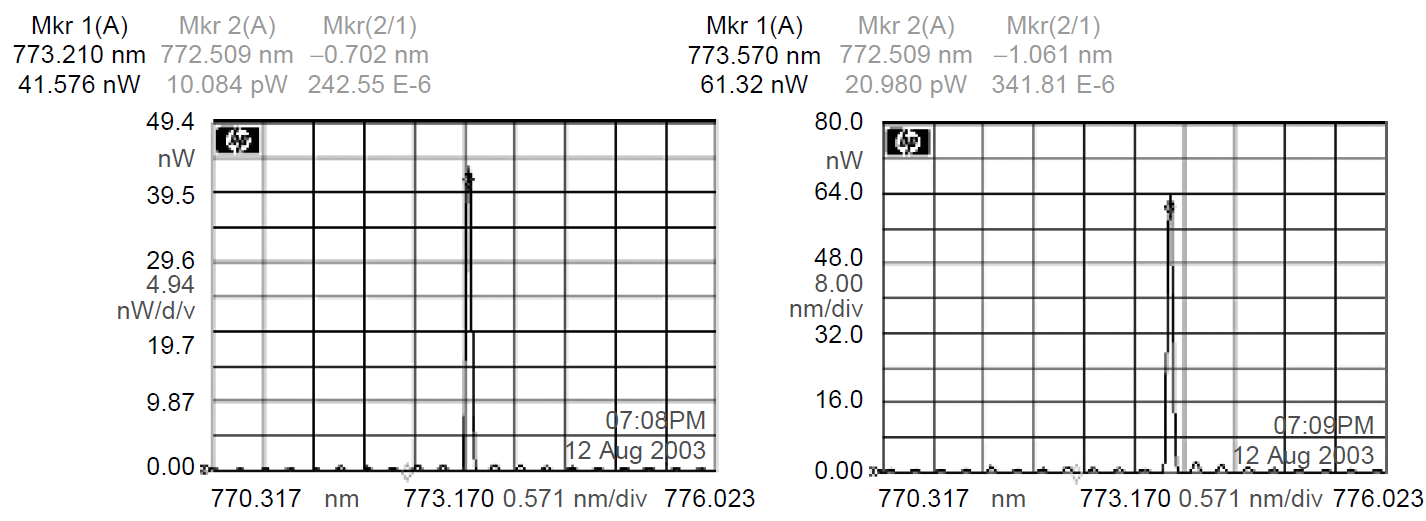


 الفيزياء الكلاسيكية
الفيزياء الكلاسيكية
 الكهربائية والمغناطيسية
الكهربائية والمغناطيسية
 علم البصريات
علم البصريات
 الفيزياء الحديثة
الفيزياء الحديثة
 النظرية النسبية
النظرية النسبية
 الفيزياء النووية
الفيزياء النووية
 فيزياء الحالة الصلبة
فيزياء الحالة الصلبة
 الليزر
الليزر
 علم الفلك
علم الفلك
 المجموعة الشمسية
المجموعة الشمسية
 الطاقة البديلة
الطاقة البديلة
 الفيزياء والعلوم الأخرى
الفيزياء والعلوم الأخرى
 مواضيع عامة في الفيزياء
مواضيع عامة في الفيزياء|
Read More
Date: 16-3-2016
Date: 31-1-2021
Date: 10-3-2016
|
OUTPUT CHARACTERISTICS
Spatially, the output beam from a laser diode consists of an elliptically shaped beam which is diffraction limited. Thinner dimensions, such as the thickness of the active layer, have higher divergence since gain in that direction comes primarily from photons

Figure 1.1. Typical diode laser output beam.
which are confined by the top and bottom layers of the structure and have been reflected many times. The wider active layer of the device means fewer reflections and hence lower divergence in that direction. A typical beam profile is shown in Figure 1.1. In this particular diode, a stripe contact on the top layer restricts the flow of current through the device, increasing current density in the center of the active region. Of course, VCSELs feature a circular beam that is easier to focus to a point than is the elliptical beam shown here.
The wavelength stability of a laser diode depends highly on the temperature of the diode. As the temperature of a laser diode increases, the refractive index of the semiconductor material itself changes. Since the resonant wavelength of a cavity depends on the refractive index of the material, the wavelength shifts toward longer wavelengths as the temperature of the device increases. The output wavelength of a conventional laser diode increases more or less linearly as temperature does. Figure 1.2 shows the spectral output of a typical laser diode at a current of 83.9 and 111.9 mA, respectively. The wavelength shift is obvious in this case, about 0.36 nm toward a longer wavelength as the current is increased.
Conventional laser diodes have cavity lengths (typically, 200 to 500 μm in length) which are long enough to allow several longitudinal modes to oscillate simultaneously. In the spectrum of the typical diode shown in Figure 1.3, modes spaced 0.288 nm apart are evident in the wavelength sweep. In this case, modes are made evident by operating the diode at a current just above threshold, where the output consists of a good deal of broadband (spontaneous) output. The resonant wavelengths of the cavity separate the output spectrum into many modes, as evident in the figure. As the current through the device increases, a dominant mode appears and the output resembles that of Figure 1.2.
The output of a conventional laser diode consists of many closely spaced longitudinal modes which lead collectively to a large spectral bandwidth in the output of

Figure 1.2. Laser diode wavelength at increasing current.
the device. Even with a single-mode laser, temperature can affect the output spectra, since as temperature changes, the wavelength at which the cavity is resonant shifts and the laser can hop between allowed longitudinal modes. Again, temperature control is required to ensure wavelength stability.
While the output spectral width can be restricted by using a wavelength selector such as a DFB grating, another approach, used in VCSEL lasers, is to reduce the length of the cavity so that only a single mode is supported. VCSELs feature an extraordinarily thin active layer (less than 100 nm), with resonator optics fabricated above and below the semiconductor crystal. The entire cavity (usually less than 5 μm) is thin enough that only a single longitudinal mode is supported. Some

Figure 1.3. Laser diode modes.
VCSELs have cavities large enough to support several modes, but spectral output is still narrow compared to an edge-emitting diode since modes are separated by a larger amount than in a conventional diode. The thin dimensions of the cavity result inb resonant peaks which are spaced farther apart than in a longer cavity.
As we mentioned, the wavelength stability of a laser diode depends highly on the temperature of the diode. As the temperature of a laser diode increases, the refractive index of the semiconductor material itself changes. Since the resonant wavelength of a cavity depends on the refractive index of the material, the wavelength shifts toward the red as temperature of the device increases. The output wavelength of a normal multimode laser diode increases more or less linearly as temperature does. For a single-longitudinal-mode (i.e., single-frequency) laser diode, though, the output wavelength can shift abruptly as the temperature fluctuates in what is called mode hopping. This is caused by the nature of the cavity, which is resonant only at discrete wavelengths (separated by the FSR of the cavity). As temperature increases and resonant wavelength increases, the output can shift from resonance at one mode to the next. For this reason, laser diodes require temperature stabilization, often in the form of a thermoelectric cooler built into the diode to stabilize the output wavelength.
Semiconductors have a wide gain width (output can span over several nanometers), so are relatively broadband sources compared with gas lasers. The output of a typical diode laser is multimode, consisting of a series of peaks (longitudinal modes) spaced by the FSR of the relatively small cavity, although at high drive currents a dominant mode often appears. Optical structures can be implemented which serve to reduce the spectral width of the output.
As well as longitudinal modes, transverse modes may also appear in the output, but these may be restricted in the same manner as used with other lasers, by limiting the size of the active region. In an index-guided laser (those utilizing hetero structures), selection of layer size can effectively limit the gain aperture and hence force the laser to operate strictly in TEM00 mode. Unfortunately, small apertures lead to large divergences in the output beam, so most lasers with restricted apertures require the use of an external lens to collimate the exiting beam.



|
|
|
|
دخلت غرفة فنسيت ماذا تريد من داخلها.. خبير يفسر الحالة
|
|
|
|
|
|
|
ثورة طبية.. ابتكار أصغر جهاز لتنظيم ضربات القلب في العالم
|
|
|
|
|
|
|
قسم شؤون المعارف ووفد من جامعة البصرة يبحثان سبل تعزيز التعاون المشترك
|
|
|